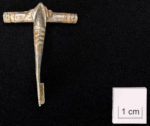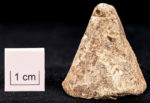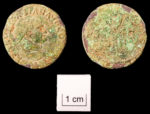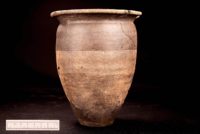 A rich Roman cemetery has been discovered at the site of new school construction in Somerton, county of Somerset, southwest England. The remains of more than 50 individuals, adults and children, dating from 43-410 A.D. were unearthed. The quality of the graves and the goods interred indicate these were people of wealth and status.
A rich Roman cemetery has been discovered at the site of new school construction in Somerton, county of Somerset, southwest England. The remains of more than 50 individuals, adults and children, dating from 43-410 A.D. were unearthed. The quality of the graves and the goods interred indicate these were people of wealth and status.
 Located on a ridge between two rivers, the Yeo and Cary, Somerton has been populated since prehistory. Most of the archaeological evidence of Somerton’s pre-Roman occupation consists of enclosures, field boundaries, crop marks and earthworks, not building structures or artifacts per se. It’s not until the Roman era that archaeological remains attesting to it having been a heavily permanent
Located on a ridge between two rivers, the Yeo and Cary, Somerton has been populated since prehistory. Most of the archaeological evidence of Somerton’s pre-Roman occupation consists of enclosures, field boundaries, crop marks and earthworks, not building structures or artifacts per se. It’s not until the Roman era that archaeological remains attesting to it having been a heavily permanent  settlement. At least nine significant Romano-British farms or villas have been discovered. This indicates Somerton was an important agricultural hinterland for the urban center Lindinis (modern-day Ilchester),a 1st century Roman fort that by the 4th century had grown into a prosperous walled town replete with luxury homes. A Roman road has been discovered that linked Somerton to Lindinis nine miles to its south.
settlement. At least nine significant Romano-British farms or villas have been discovered. This indicates Somerton was an important agricultural hinterland for the urban center Lindinis (modern-day Ilchester),a 1st century Roman fort that by the 4th century had grown into a prosperous walled town replete with luxury homes. A Roman road has been discovered that linked Somerton to Lindinis nine miles to its south.
 Burials believed to date to the Roman period have been found before — two in the vicarage garden in 1951, six in 1889 — but the dating is not firm. This is not only the first time a full Roman cemetery has been found in Somerton, but the first modern archaeological excavation of a Roman cemetery in all of Somerset. The excavation and analysis of the findings will shed new light on the transition from Iron Age British to Romano-British to Romanized life and death in Somerset.
Burials believed to date to the Roman period have been found before — two in the vicarage garden in 1951, six in 1889 — but the dating is not firm. This is not only the first time a full Roman cemetery has been found in Somerton, but the first modern archaeological excavation of a Roman cemetery in all of Somerset. The excavation and analysis of the findings will shed new light on the transition from Iron Age British to Romano-British to Romanized life and death in Somerset.
 The graves were dug in clean rectangles and then lined with local stones. After people were laid to rest, the graves were sealed with flat slabs. One of them was capped with a tented stone roof. These types of graves were expensive and time-consuming to build, rare in Roman Britain and extremely rare for a whole burial ground to be full of them.
The graves were dug in clean rectangles and then lined with local stones. After people were laid to rest, the graves were sealed with flat slabs. One of them was capped with a tented stone roof. These types of graves were expensive and time-consuming to build, rare in Roman Britain and extremely rare for a whole burial ground to be full of them.
The grave goods include pottery, jewelry, coins, a carved bone artifact (probably a knife handle). One large pot contained a chicken wing bone, the  remains of a funerary offering. Small nails found at the foot of most of the are likely the remains of hobnailed boots. While the organic material has decayed, the position of one woman’s head suggests it was originally resting on a pillow.
remains of a funerary offering. Small nails found at the foot of most of the are likely the remains of hobnailed boots. While the organic material has decayed, the position of one woman’s head suggests it was originally resting on a pillow.
[South West Heritage Trust archaeologist Steve] Membery believes the people who have been found would have lived and worked in a nearby Roman villa. The villa has yet to be discovered but what is believed to be an outhouse and a barn associated with it have been found.
Evidence has also been uncovered of an iron-age settlement predating the Roman cemetery. Membery said one of the most interesting elements of the cemetery was that it showed how local people adopted Roman burial customs. Bodies were squashed into the oldest graves but laid flat, in the Roman style, in the later ones, and grave goods were placed close to the head.
DNA analysis will be carried out to try to learn more about the people who were buried at Somerton. It is thought likely they were British people who had adopted Roman customs after the invasion.
The school construction was delayed during the excavation, but it will pick up again next month. The artifacts and human remains have been salvaged and will be studied further.

